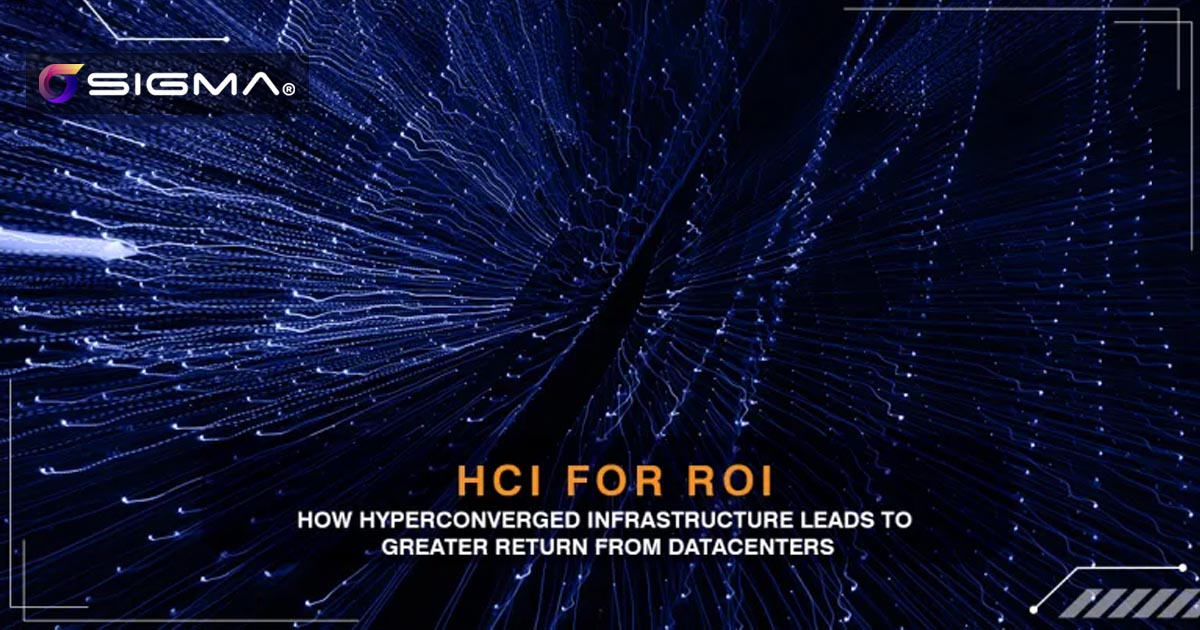
HCI for ROI: How Hyperconverged Infrastructure Leads to Greater Return from Datacenters
Throughout the past decade (and in many cases even long before that), businesses and governments saw the crucial imperative for digital transformations and ensured they had strategies in place for digital migration. Those who hadn’t awoken to that necessity, were made acutely aware of it during the COVID years.
Corporate datacenters have been witnessing their own form of “digital transformation”: migrating from hardware-dependent discrete compute, network, and storage to virtualization. Ever since the emergence of virtualization in the 1960s, it has been growing in uptake in IT infrastructures, evolving in concept to allow more flexible computing. In 2023, the virtual machine industry stands at USD 27.9 billion, and is expected to grow with a compound annual growth rate of 20.3% over the next decade, reaching USD 177.3 billion in 2033.
But not all virtualization is created equal.
Organizations may have legitimate reasons for not opting for cloud infrastructures. HCI may offer a solution to ensure the most efficient use of hardware resources
While cloud architectures may be the end of the spectrum, some organizations may have legitimate reasons for not opting for a full cloud infrastructure. In cases like these, hyper-converged infrastructure (HCI) may offer a solution to ensure the most efficient use of hardware resources, avoiding overprovisioning, and shifting the cost model from CAPEX to OPEX, a much more sustainable strategy in today’s volatile, unstable, complex, and ambiguous environment.
This article presents an argument for Hyperconverged Infrastructure
Hyperconverged Infrastructure (HCI) Is on the Rise
Market research company, IMARC, reports a huge spike in the need for flexible infrastructures, especially in the wake of the COVID pandemic. The HCI market was valued at USD 7.5 billion in 2021, and at a compound annual growth rate of 26.1% it is estimated to reach a market size of USD 29.4 billion by 2027.
Before diving into the reason for shifting into a different infrastructure architecture, you might like to review the arguments supporting virtualization.
The HCI market is estimated to reach a market size of USD 29.4 billion by 2027.
HCI: The Datacenter of the Future

Since HCI describes the final architecture of pooled, virtualized, and scalable resources for compute, storage, storage networking, and management (rather than the path taken to achieve that end), there are many paths that could lead to hyperconvergence.
Hyperconvergence’s benefits for an organization’s infrastructure are countless; some of which are mentioned below.
HCI Streamlines Setup, Maintenance, & Provisioning of Resources
When it comes to server hardware, x86 servers are the industry standard and they keep getting better. They are off-the-shelf and so common, that any operating system or application can run smoothly on them; almost all of them are created with x86 servers in mind. Being generic means that these servers are much cheaper than purpose-built hardware.
By abstracting the hardware, hyperconvergence can make use of industry-standard x86 servers. This cuts down costs significantly since IT departments no longer need to acquire purpose-built (ultimately more expensive) hardware. And generic hardware will not require highly specialized personnel that are knowledgeable in niche hardware, leading to a smaller, lighter team as well. Since workloads are balanced more efficiently, fewer machines can be acquired to achieve the same end.
There are many paths that could lead to hyperconvergence.
Generic hardware means the cost of setting up and maintaining the datacenter is greatly reduced. With hyperconvergence, an IT system can achieve the same performance with a smaller capital investment, a smaller footprint, a smaller team with more general skillsets, a lower running cost, and less staff time in operation and management of the datacenter.
HCI: A New Horizon for Data Storage

Traditionally, infrastructures employed direct attached storage and network attached storage. Hyperconverged storage differs from the traditional storage model in that it delivers logical control of storage through software, rather than physical control of specific hardware devices
HCI solves the issue of storage capacity requirements by pooling any direct attached storage (such as flash drives or hard disk drives) and abstracting it into a seemingly single shared storage. This allows it to simulate traditional SAN or NAS devices. Flash storage, being high-density, allows higher storage capacities at lower costs.
IT systems can achieve the same performance with a smaller capital investment, a smaller footprint, a smaller team with more general skillsets, a lower running cost, and less staff time in operating and managing the datacenter.
An added leverage is that HCI almost eliminates “network hop”, so that the data can be processed on CPUs closer to storage, which greatly augments the speed of flash storage.
Hyperconverged storage delivers greater flexibility through virtualizing the hardware, allowing automated provisioning as needed by the workloads. Storage can scale incrementally based on the needs of the organization, allowing a pay-as-you-go model rather than an upfront investment.
HCI saves costs by shifting the cost model from CAPEX to OPEX, while also opting for generic industry-standard hardware, resulting in a more streamline and efficient datacenter.
The Hypervisor: The Foundation of HCI
The hypervisor is the critical factor in hyperconvergence, as it is the layer responsible for the abstraction and provisioning of the underlying hardware resources.
Choosing a hypervisor depends on the function it will carry out, as well as the size & criticality of the workload, tolerated latencies, projected costs (including licensing costs), the existing infrastructure, and the skills of available staff matching the complexity of managing it.
HCI saves costs by shifting the cost model from CAPEX to OPEX, while also opting for generic industry-standard hardware, resulting in a more streamline and efficient datacenter.
Expert administrators can configure the hypervisor’s provisioning of resources according to business requirements, addressing which applications have priority and peak usage times. They can also isolate different VMs from each other to separate different functions and control access.
Only through proper selection and configuration of the hypervisor can an organization ensure its resources are being utilized most efficiently, which is probably why they opted for HCI in the first place. Bearing the costs of conversion to HCI and not optimizing the hypervisor means not getting a satisfactory ROI.
The security of the hypervisor is a critical component, as a compromised hypervisor means all VMs running on top of it are exposed. Thorough knowledge of the inner workings and risks of the hypervisor is a must to ensure a secure hyperconverged infrastructure.

Other Factors Needed for Successful HCI
Other elements that make up the hyperconverged infrastructure must all be orchestrated with the Hypervisor to deliver the best overall performance. Best-fitting these components together requires up-to-date knowledge of hardware and software options, as well as thorough analysis of the business needs and limitations, including the regulatory framework of the industry and geographical region.
Proper selection and configuration of hypervisors can organizations ensure resources are utilized efficiently, which is why they opted for HCI. Bearing the costs and not optimizing the hypervisor usually means poor ROI.
The elements that complement the hypervisor include:
- Reliable storage. While previously a storage appliance needed to be integrated with the infrastructure, next-generation HCI solutions allow tight integration between servers and virtualized storage, negating the need for such devices.
- A simple management interface that makes it intuitive to manage everything from a single pane of glass.
- Flexible deployment options that allow an organization to make the best of all worlds, merging infrastructures between the datacenter and public, private, or hybrid clouds.
Use Cases for HCI
As a versatile technology could have a vast multitude of use cases, depending on the organization’s needs. Below are a handful of use cases, those that would especially benefit from a hyperconverged infrastructure.
Best-fitting components together requires knowledge of options, and thorough analysis of business needs and limitations, including regulatory frameworks.
- Analytical & informational use cases such as business intelligence, data warehousing, data marts, virtual sandboxing, staging, or conducting big data analytics.
- Operational and transactional use cases, which include data services for agile application development, data abstraction for migration & modernization, B2B data services, customer service and call centers, product catalogs, vertical-specific data (such as for physicians).
- Web & cloud integration use cases such as competitive business intelligence, public source information, social media integration, SaaS application integration, B2B integration through web automation.
- Data management use cases for enterprise business data glossary, enterprise data services, unified data governance, or virtual master data management.
- Storage-specific use cases that are made possible through hyperconvergence, which include general-purpose data storage supporting a range of storage protocols, storing of data from VMs, supporting databases, virtual desktop infrastructure (VDI), data protection for backup and disaster recovery, edge computing, branch and remote office deployments with on-site servers, and acting as a foundation for private and hybrid clouds.

In Summary…
Hyperconverged infrastructure is not “new”; the concept has been around since 2009, with Nutanix introducing the first HCI-specific product in 2011. The technology continues to evolve, not only on its own, but in the context of a larger landscape of IT solutions. As other technologies emerge and evolve, we will need to always remain on the lookout for the ways in which these solutions integrate and enhance each other, and for the more powerful up-and-coming alternatives that will render our current solutions obsolete.
